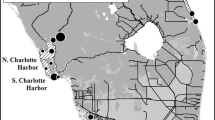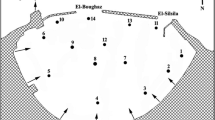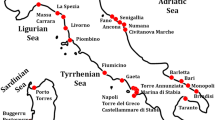Abstract
Sediments in the Port Jackson estuary are polluted by a wide range of toxicants and concentrations are among the highest reported for any major harbor in the world. Sediment quality guidelines (SQGs), developed by the National Oceanographic and Atmospheric Administration (NOAA) in the United States are used to estimate possible adverse biological effects of sedimentary contaminants in Port Jackson to benthic animals. The NOAA guidelines indicate that Pb, Zn, DDD, and DDE are the most likely contaminants to cause adverse biological effects in Port Jackson. On an individual chemical basis, the detrimental effects due to these toxicants may occur over extensive areas of the harbor, i.e., about 40%, 30%, 15% and 50%, respectively. The NOAA SQGs can also be used to estimate the probability of sediment toxicity for contaminant mixtures by determining the number of contaminants exceeding an upper guideline value (effects range medium, or ERM), which predicts probable adverse biological effects. The exceedence approach is used in the current study to estimate the probability of sediment toxicity and to prioritize the harbour in terms of possible adverse effects on sediment-dwelling animals. Approximately 1% of the harbor is mantled with sediment containing more than ten contaminants exceeding their respective ERM concentrations and, based on NOAA data, these sediments have an 80% probability of being toxic. Sediment with six to ten contaminants exceeding their respective ERM guidelines extend over approximately 4% of the harbor and have a 57% probability of toxicity. These areas are located in the landward reaches of embayments in the upper and central harbor in proximity to the most industrialised and urbanized part of the catchment. Sediment in a further 17% of the harbor has between one and five exceedences and has a 32% probability of being toxic. The application of SQGs developed by NOAA has not been tested outside North America, and the validity of using them in Port Jackson has yet to be demonstrated. The screening approach adopted here is to use SQGs to identify contaminants of concern and to determine areas of environmental risk. The practical application and management implications of the results of this investigation are discussed.
Similar content being viewed by others
Author information
Authors and Affiliations
Rights and permissions
About this article
Cite this article
Birch, G., Taylor, S. Application of Sediment Quality Guidelines in the Assessment and Management of Contaminated Surficial Sediments in Port Jackson (Sydney Harbour), Australia. Environmental Management 29, 860–870 (2002). https://doi.org/10.1007/s00267-001-2620-4
Issue Date:
DOI: https://doi.org/10.1007/s00267-001-2620-4




